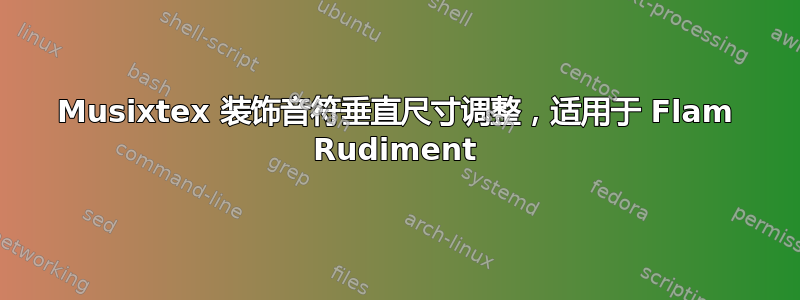
Flam Rudiment 需要调整花音的垂直大小,代码如下:
\documentclass[tikz,border=3mm]{standalone}
\usepackage[T1]{fontenc}
\usepackage{polyglossia}
\setmainlanguage{spanish}
\usepackage{tikz}
\usetikzlibrary{arrows.meta, calc}
\tikzstyle{every picture}+=[remember picture]
\usepackage{pifont} % Para usar simbolos ding
\usepackage{musicography}
\usepackage{musixtex}
\input{musixlyr}
\input {musixcho}
\input {musixdat}%fecha
\input {musixfll}
\input {musixgre}%gregoriano
\input {musixper}%percusión
\input {musixppff}
\input {musixstr}
\input {musixvbm} % experimental vectorized beams
\input {musixdbr} % lineas de barras punteadas, discontinuas y arbitrariamente discontinuas
\input {musixbm} % compatibilidad garrapateas con ganchos o con barras
\input {musixbbm} % compatibilidad semi garrapateas con ganchos o con barras
\begin{document}
\begin{music}
\largemusicsize
\setlines{1}{0}
\setclefsymbol{1}{\empty}%
\nobarnumbers
\nostartrule
\startextract
{\Huge{\textcircled{\large 20}}}$\quad$
\NOtes\smallnotesize\islurd0a\zcharnote{-11}{\textbf\scriptsize \hspace*{-0.08cm} L}\grcu a\en
\notes \tslur0a\zcharnote{-10}{\textbf\small \hspace*{-0.08cm} R}\qu a \en
\NOtes\smallnotesize\islurd0a\zcharnote{-11}{\textbf\scriptsize \hspace*{-0.08cm} R}\grcu a\en
\notes \tslur0a\zcharnote{-10}{\textbf\small \hspace*{-0.08cm} L}\qu a \en
\zendextract
\end{music}
\end{document}
答案1
由于某种原因,装饰音的音符级别必须为start at d最低,而不是 a。
请查看下面的代码。在序言中,我跳过了所有不必要的部分,这些部分可能会分散注意力;文章文档只是提供了更漂亮的打印输出。
%\documentclass[tikz,border=3mm]{standalone}
\documentclass{article}
\usepackage{musixtex}
\begin{document}
\section{Locating the problems}
\begin{itemize}
\item removed unecessary parts
\item used normal staff to see impacts
\item copied code from page 101
\item !! note has to be at least \emph{d} !!
\end{itemize}
\begin{music}
%\instrumentnumber{1}% not needed
\largemusicsize
%\setlines{1}{0}% removed, to better see the effect
\setclefsymbol{1}{\empty}%
\nobarnumbers
\nostartrule
\startextract
% copy from page 101: does it work at all?
\NOTes\hu h\en
\notes\multnoteskip\smallvalue\smallnotesize\grcu d\en% !! needs to be at least d !!
\NOTes\hu i\en
\bar
{\Huge{\textcircled{\large 20}}}$\quad$
\NOtes\multnoteskip\smallvalue\smallnotesize\grcu a\en
\notes\qu a \en
\NOtes\multnoteskip\smallvalue\smallnotesize\grcu d\en
\notes\qu d \en
% \NOtes\smallnotesize\islurd0a\zcharnote{-11}{\textbf\scriptsize \hspace*{-0.08cm} L}\grcu a\en
% \notes \tslur0a\zcharnote{-10}{\textbf\small \hspace*{-0.08cm} R}\qu a \en
% \NOtes\smallnotesize\islurd0a\zcharnote{-11}{\textbf\scriptsize \hspace*{-0.08cm} R}\grcu a\en
% \notes \tslur0a\zcharnote{-10}{\textbf\small \hspace*{-0.08cm} L}\qu a \en
\zendextract
\end{music}
\section{Adjusting to note level d}
\begin{music}
\largemusicsize
\setlines{1}{0}
\setclefsymbol{1}{\empty}%
\nobarnumbers
\nostartrule
\startextract
{\Huge{\textcircled{\large 20}}}$\quad$
\NOtes\smallnotesize\islurd0a\zcharnote{-11}{\textbf\scriptsize \hspace*{-0.08cm} L}\grcu d\en
\notes \tslur0a\zcharnote{-10}{\textbf\small \hspace*{-0.08cm} R}\qu d \en
\NOtes\smallnotesize\islurd0a\zcharnote{-11}{\textbf\scriptsize \hspace*{-0.08cm} R}\grcu d\en
\notes \tslur0a\zcharnote{-10}{\textbf\small \hspace*{-0.08cm} L}\qu d \en
\zendextract
\end{music}
\section{Original code}
% original code
\begin{music}
\largemusicsize
\setlines{1}{0}
\setclefsymbol{1}{\empty}%
\nobarnumbers
\nostartrule
\startextract
{\Huge{\textcircled{\large 20}}}$\quad$
\NOtes\smallnotesize\islurd0a\zcharnote{-11}{\textbf\scriptsize \hspace*{-0.08cm} L}\grcu a\en
\notes \tslur0a\zcharnote{-10}{\textbf\small \hspace*{-0.08cm} R}\qu a \en
\NOtes\smallnotesize\islurd0a\zcharnote{-11}{\textbf\scriptsize \hspace*{-0.08cm} R}\grcu a\en
\notes \tslur0a\zcharnote{-10}{\textbf\small \hspace*{-0.08cm} L}\qu a \en
\zendextract
\end{music}
\end{document}
答案2
解决方案只需要 stdstemfalse 命令如下:
\documentclass[tikz,border=3mm]{standalone}
\usepackage[T1]{fontenc}
\usepackage{polyglossia}
\setmainlanguage{spanish}
\usepackage{tikz}
\usetikzlibrary{arrows.meta, calc}
\tikzstyle{every picture}+=[remember picture]
\usepackage{pifont} % Para usar simbolos ding
\usepackage{musicography}
\usepackage{musixtex}
\input{musixlyr}
\input {musixcho}
\input {musixdat}%fecha
\input {musixfll}
\input {musixgre}%gregoriano
\input {musixper}%percusión
\input {musixppff}
\input {musixstr}
\input {musixvbm} % experimental vectorized beams
\input {musixdbr} % lineas de barras punteadas, discontinuas y arbitrariamente discontinuas
\input {musixbm} % compatibilidad garrapateas con ganchos o con barras
\input {musixbbm} % compatibilidad semi garrapateas con ganchos o con barras
\begin{document}
{\sffamily\bfseries
\begin{music}
\largemusicsize
\setlines{1}{0}
\setclefsymbol{1}{\empty}%
\def\snotes{\vnotes2.3\elemskip}
\nobarnumbers
\nostartrule
\startextract
{\Huge{\textcircled{\large 20}}}$\quad$
\snotes\tinynotesize\islurd0a\zcharnote{-11}{\hspace*{-0.08cm} \footnotesize\textbf L}\grcu{d}\en
\notes \tslur0a\zcharnote{-10}{\hspace*{-0.08cm} \textbf\small R}\qu d \en
\snotes\stdstemfalse\tinynotesize\islurd0a\zcharnote{-11}{\hspace*{-0.08cm} \footnotesize\textbf R}\grcu a\en
\notes \tslur0a\zcharnote{-10}{\hspace*{-0.08cm} \textbf\small L}\qu a \en
\zendextract
\end{music}
}
\end{document}






